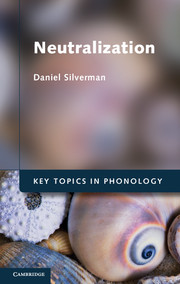Book contents
- Frontmatter
- Contents
- List of Figures
- Preface
- Acknowledgments
- 1 The rhyme and the reason of neutralization
- Part I Rhyme
- Section A Observation and description
- Section B False positives
- Section C Explanation
- Section D Exemplification
- 12 Case study
- 13 Domains of application
- 14 “Distinctions are drawn that matter”
- Part II Reason
- Glossary
- References
- Language index
- Subject index
13 - Domains of application
Published online by Cambridge University Press: 05 November 2012
- Frontmatter
- Contents
- List of Figures
- Preface
- Acknowledgments
- 1 The rhyme and the reason of neutralization
- Part I Rhyme
- Section A Observation and description
- Section B False positives
- Section C Explanation
- Section D Exemplification
- 12 Case study
- 13 Domains of application
- 14 “Distinctions are drawn that matter”
- Part II Reason
- Glossary
- References
- Language index
- Subject index
Summary
In Chapter 11 we considered in some detail the mechanism by which anti-homophony might act as a passive pressure on language change, discussing Labov's (1994) semantic misperception proposals (also, by the way, considered in Silverman 2000, 2004, 2006a, 2006b, Blevins and Wedel 2009, and Mondon 2009). Recall: neutralization may result in a semantically ambiguous speech signal. Those tokens of words that are not confusable with other words are more likely to be successfully recovered by listeners, hence are more likely to be produced as these listeners become speakers, and consequently are more likely to become the conventionalized speech norm. Recall further that, in such a scenario, there are no listener “guessing games” about speakers' phonetic intentions, no on-line monitoring of the semantic clarity of the signal, no role for teleological pressures on language structure, no need for features, segments, syllables, or underlying representations. Instead, due to passive diachronic pressures on language use, the system naturally settles towards a semantically unambiguous state, one involving low levels of homophony; low levels of neutralization.
In Chapter 12 we investigated alternation in Korean as a testing ground for the role of neutralization in language evolution. We found that, despite the fact that Korean possesses a huge amount of (traditional) neutralizing alternation, the amount of neutralization is remarkably low. The overarching proposal, then, was that increases in phonological rhyme may be tolerated to the extent that undue decreases in phonological reason are avoided.
- Type
- Chapter
- Information
- Neutralization , pp. 140 - 148Publisher: Cambridge University PressPrint publication year: 2012



